Why do some brands connect well with their audience while others fall flat? The answer isn't guesswork. It's data.
Social media data cuts through the chaos. It can help transform raw engagement metrics, audience behavior, and competitor benchmarks into actionable strategies.
Take a look at how to start collecting social media data and use it to build successful marketing campaigns.
Key takeaways
- Differences between social media data and social media metrics - from business impact to privacy considerations.
- Important data points for digital marketers imply engagement data, follower information, KPIs analysis, competitive insights, mentions, sentiment and industry benchmarks.
- Social media data collection methods can be very diverse, depending on the objective. There are analytics and tools that help with data gathering, but also surveys and polls can be used.
What is social media data?
Social media data refers to the raw data and information collected from social platforms. It tracks how users engage with your social media content and measures the impact of your content.
Data collection for social media marketing isn’t just about numbers. It’s about translating user interactions into actionable strategies.
The social data can be in different formats, including numbers, ratios, and percentages. The exact format will depend on the type of data you’re collecting.
Take a look at the most important social media data points to track, including:
- Followers: The total number of users who have followed your profile or page.
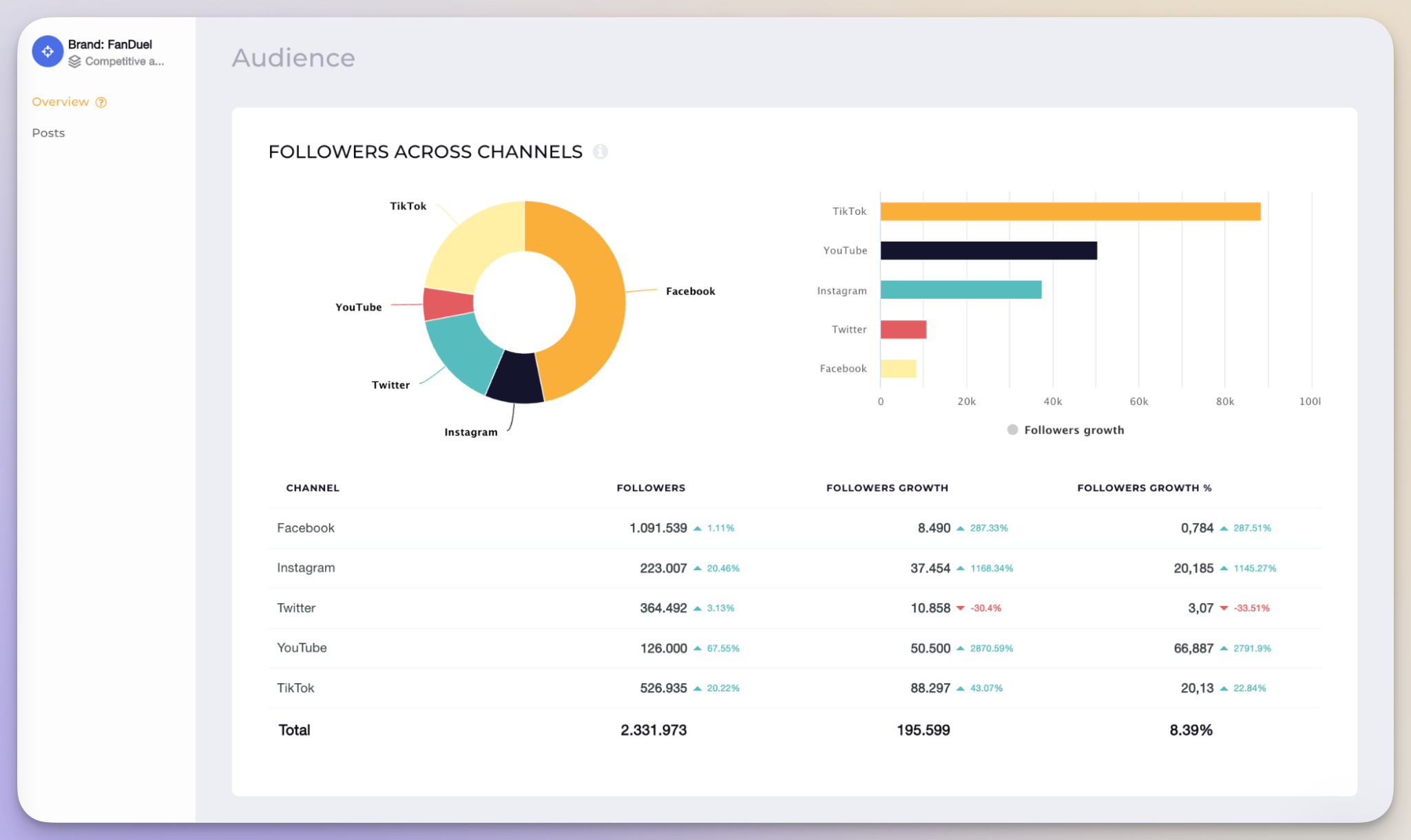
- Engagement rate per post: The percentage of people who interact with your content compared to the number of followers or reach.
- Total engagement: The sum of all interactions (likes, comments, and shares) on your posts over a specific period.

- Reach: The number of unique users who have seen your content.
- Impressions: The total number of times your content has been displayed, including repeated views from the same users.
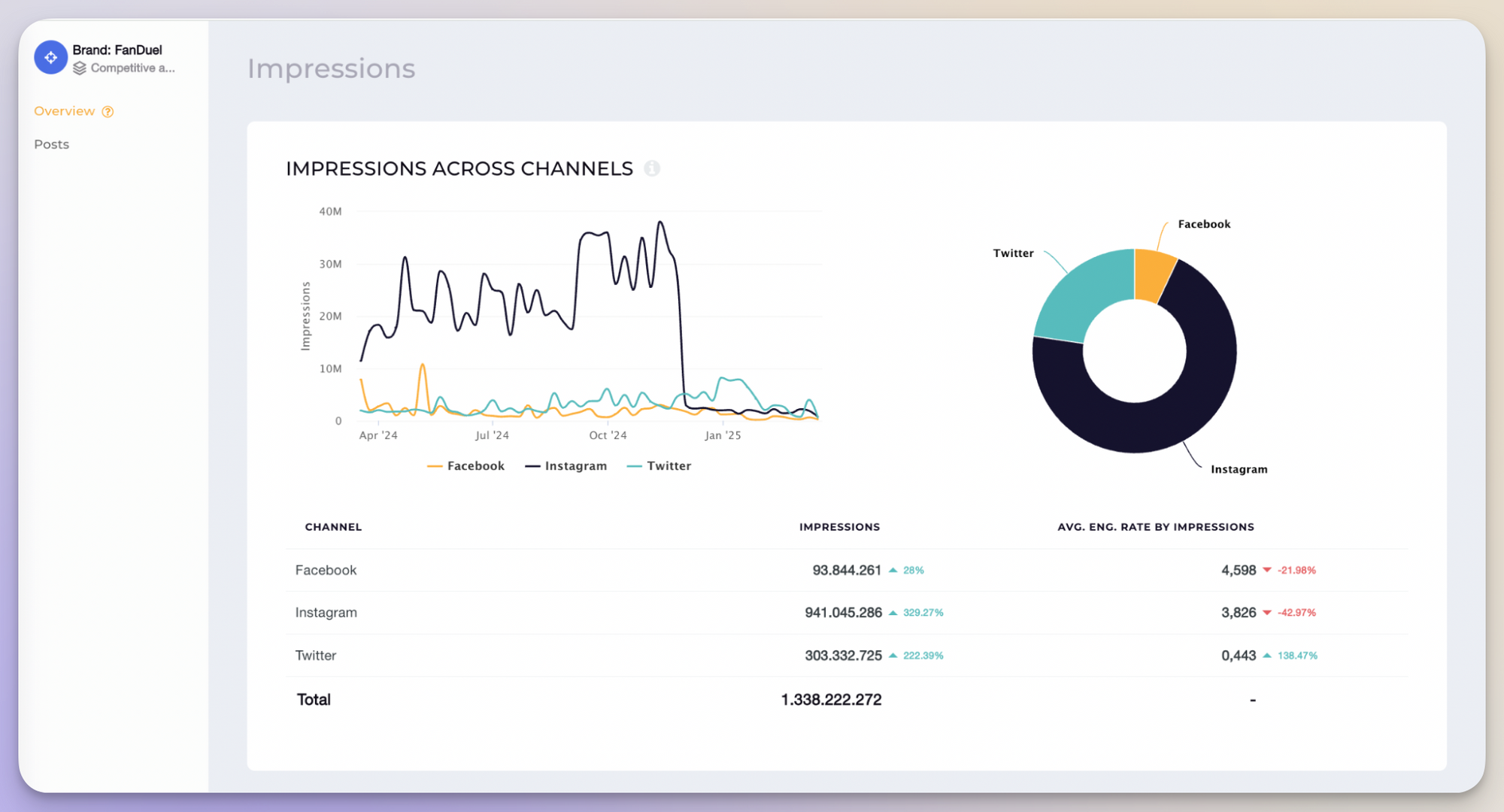
- Video views: The number of times a video has been watched for at least a defined duration (varies by platform).
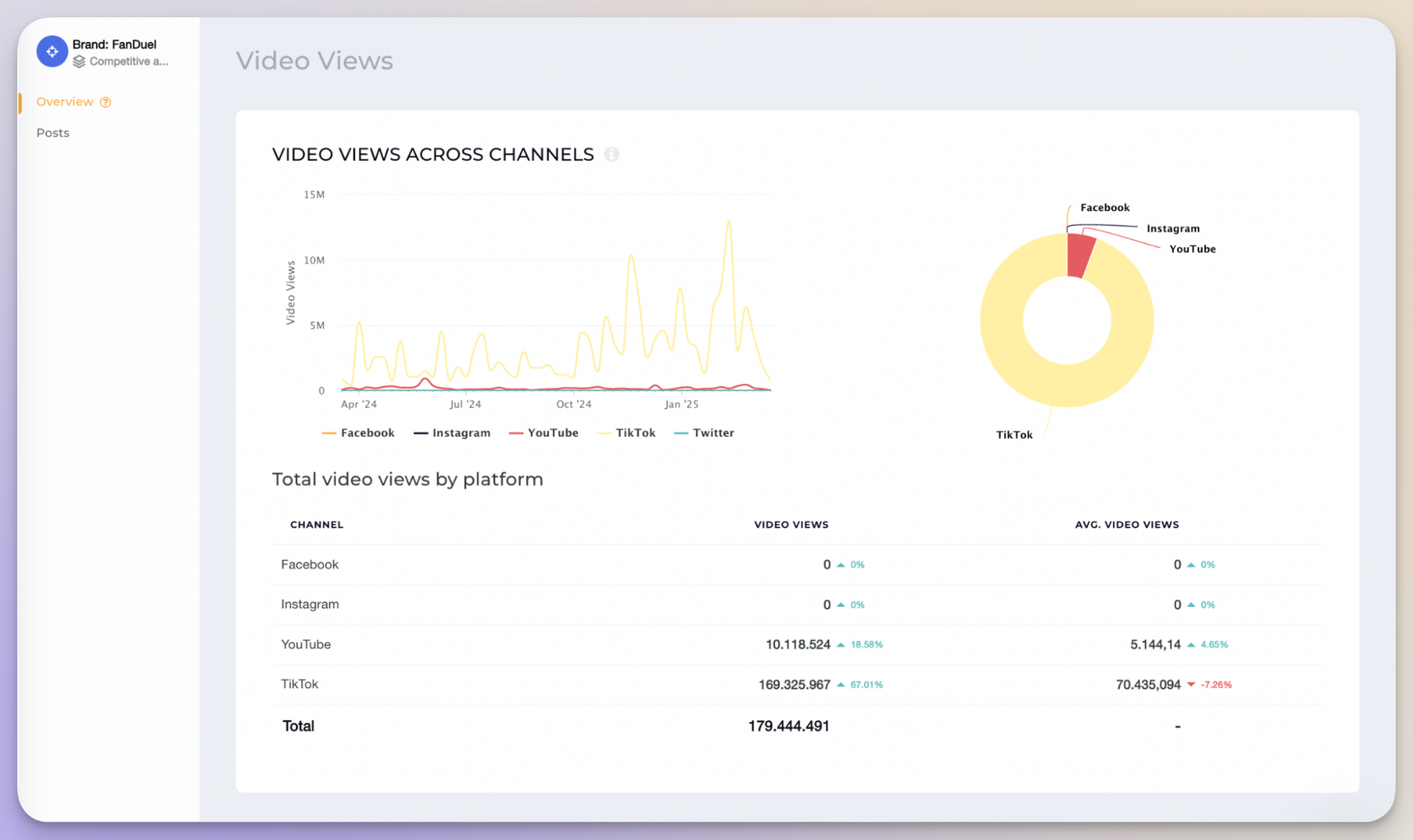
- Total number of posts: All the content pieces published on your social media profiles over a specific period of time.
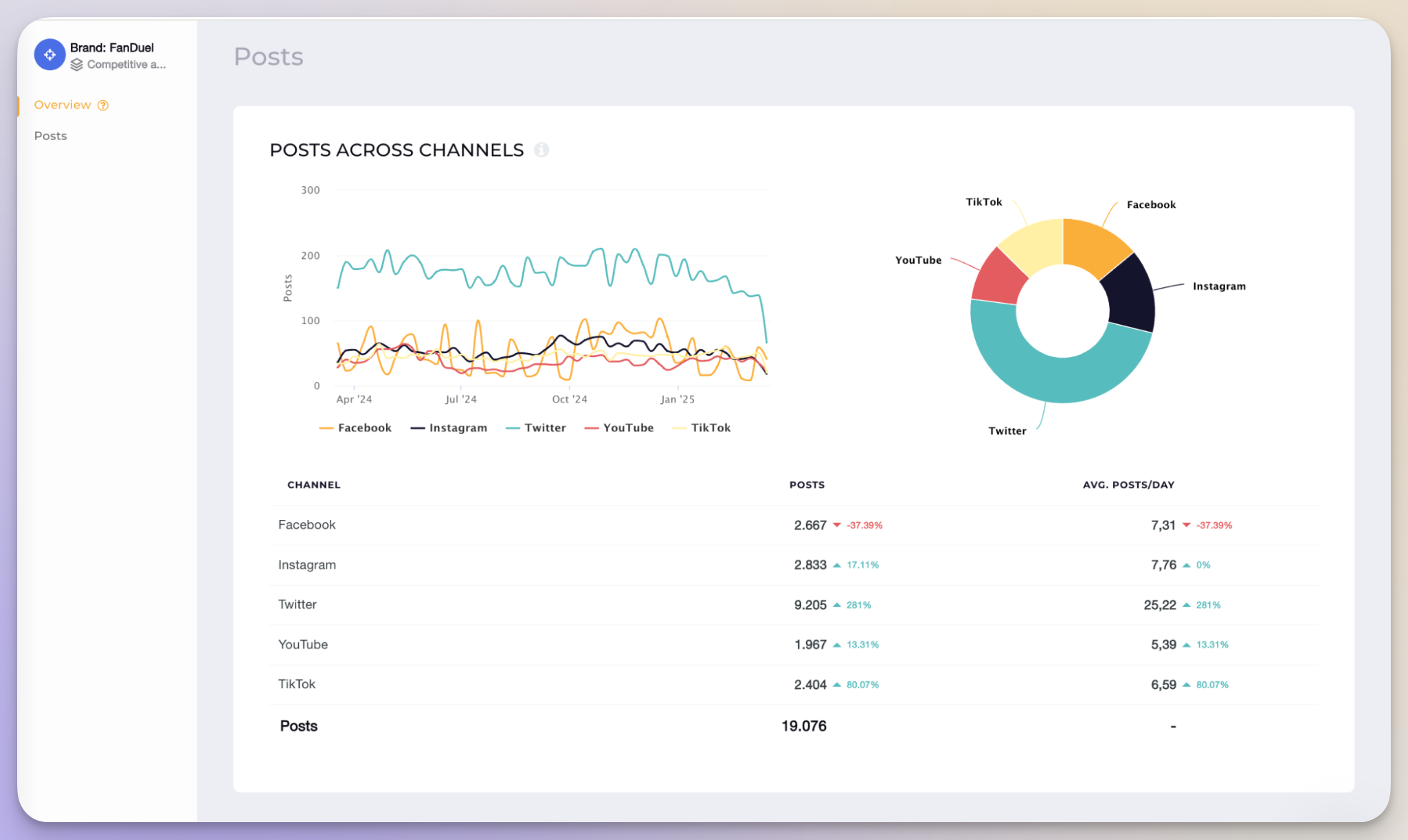
- Video length: The duration of a video, which can be measured in seconds or minutes.
- Watch time: The total time viewers have spent watching your videos.
- Likes: The number of users who have hit the like button for your post.

- Comments: The number of comments users have posted under your content.
- Shares: The number of times users have reposted your content.
- Social media benchmarks: Average performance metrics across platforms to compare your content against average results.
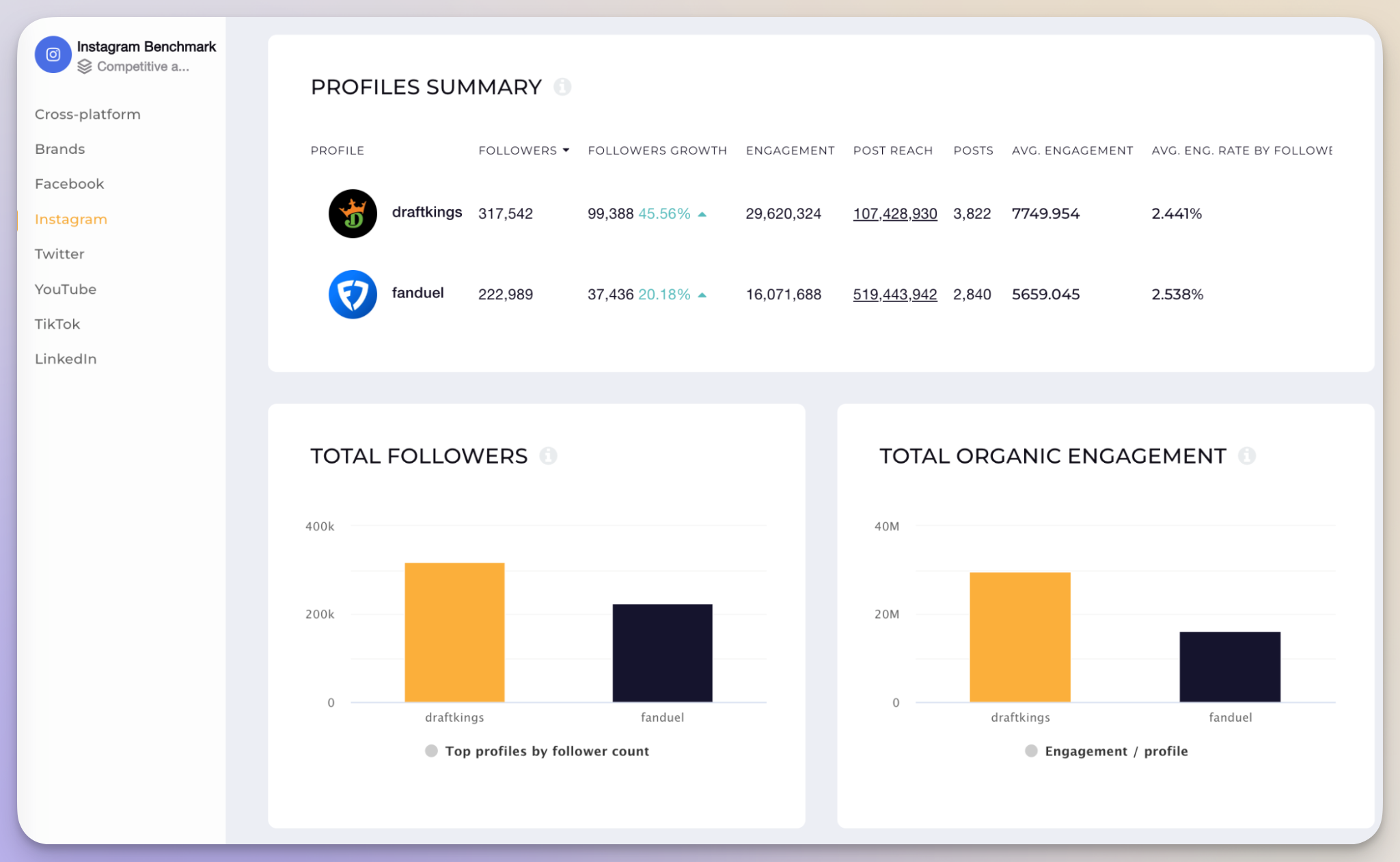
- Industry benchmarks: Average social media performance metrics specific to your business sector or niche.

Social media data vs social media metrics: key differences
While often used interchangeably, social media data and social media metrics are two distinct concepts.
Social media data is the raw, unprocessed information that’s collected from user interactions. It works as the foundation for deriving insights but is often too granular to analyze on its own.
Social media metrics, on the other hand, are the interpreted outputs derived from social media data. They include quantitative measurements like engagement rate, reach, impressions, and click-through rate.
Let's take a look at the key differences between the two:
Business impact
Social media data offers raw, contextual insights that indirectly support long-term strategic decisions. The granular data can help you understand audience behavior, create personalized customer experiences, and even discover hidden patterns.
Social media metrics directly influence social media strategy and decision-making. They are closely aligned with business KPIs and enable marketers to identify the best-performing campaigns that should be prioritized.
Privacy considerations
Privacy concerns are generally less with social media metrics because they are typically aggregated, anonymized, and high-level.
But raw social media data can include sensitive and identifiable user information, such as IP addresses, device types, locations, browsing behavior, and personal identifiers.
As data privacy concerns grow, so does the scrutiny around how this information is collected and used. Regulations like the EU’s General Data Protection Regulation (GDPR) and the California Consumer Privacy Act (CCPA) make it clear that brands must prioritize ethical and responsible data handling.
Social media data people are looking for
Here’s the breakdown of the most in-demand social media data types that marketers are tracking today.
Engagement data
Engagement is often the most telling sign of how content resonates with audiences. Social media insights reveal what kind of content sparks interest and drives conversations for your brand.
Marketers look at engagement data, such as:
- Likes;
- Comments;
- Shares;
- Engagement rate.
Follower information
Follower data shows how your audience is evolving. The insights help tailor your messaging to specific audience segments and even measure brand awareness over time.
Marketers look at data, such as:
- Total follower count;
- Growth rates;
- Audience breakdowns by age, location, and gender.
Content performance analysis
Analyzing content performance can help brands identify which content formats and topics deliver the strongest results. The data can then be used to build powerful content strategies for improved performance.
Marketers look at content performance data, such as:
- Content types (such as single posts, reels, and carousels);
- Top performing posts;
- Content pillars.
Competitor benchmarking
When you analyze how your competitors perform on social media, such as how often they post, what types of content they use, and how much engagement they receive, it becomes easy to pinpoint their content strategy, uncover content gaps, and position your brand better.
Marketers look at competitor data, such as:
- Content types;
- Best performing posts;
- Engagement rates;
- Posting frequency.
Posting patterns
You can use the posting pattern data to discover optimal posting times, identify high-engagement days, and ensure consistent content distribution across the week.
Marketers look at high-performing post data such as:
- Posting times;
- Number of posts published every week;
- Days of the week with the most posting activity.
Platform-specific metrics
Each social media platform has unique performance indicators, such as watch time on YouTube, saves on Instagram, or profile clicks on LinkedIn.
Tracking platform-specific metrics ensures content is optimized for each channel’s algorithm and audience behavior.
Marketers look at data such as:
- Watch time and average view duration on YouTube and TikTok;
- Saves and profile visits on Instagram;
- Reposts and link clicks on X (Twitter);
- Reactions and shares on Facebook;
- Post clicks and profile clicks on LinkedIn.
Mentions monitoring
By monitoring mentions, you get visibility into how often and where your brand is being talked about. You can detect both positive shout-outs and negative feedback in real time and respond to them quickly.
Marketers look at data such as:
- Volume of mentions over time;
- Sentiment classification (positive, neutral, negative);
- Mentions from influencers or high-reach accounts;
- Keywords or hashtags associated with brand mentions;
- Sudden increases in brand references (often tied to PR events or crises).
Content categorization
By grouping content into strategic pillars (like educational, promotional, and behind-the-scenes) and tracking the performance of each pillar, you can find out which content category drives the most engagement.
Then, you can use the insights to refine your content strategy and allocate more resources to content pillars that deliver the most impact.
Marketers look at data such as:
- Reach and impressions per content category;
- Follower growth tied to specific content types;
- Top-performing posts within each category;
- Post volume and frequency by content type;
- Cross-platform performance of different content pillars.
Industry benchmarks
Setting industry benchmarks helps you understand how your brand stacks up against competitors.
You can assess whether your brand’s engagement rates, follower growth, or posting frequency aligns with (or exceeds) industry standards.
Marketers often look at industry-level data such as:
- Average engagement rate across platforms for similar brands;
- Typical posting frequency by industry segment;
- Standard follower growth rates over time;
- Top-performing content formats in the industry;
- Reach and impressions benchmarks per post.
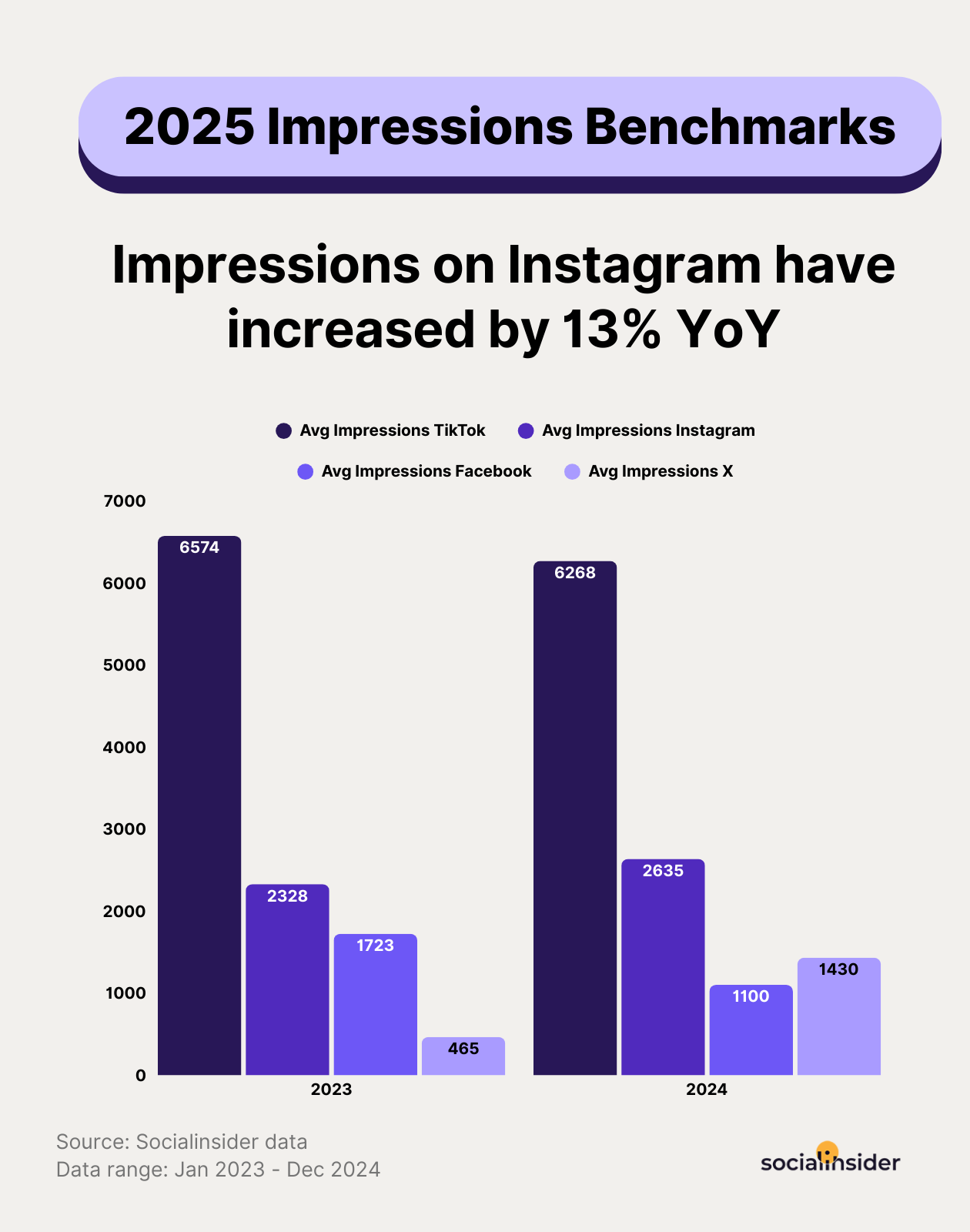
Sentiment analysis
Sentiment analysis helps brands assess how people feel about them. It’s useful for measuring brand health and campaign impact. It can also spot potential PR issues early.
Marketers monitor data such as
- Emotional tone of user comments, reviews, and shares;
- Sentiment by platform or region;
- Association of sentiment with specific keywords or topics;
- Negative sentiment spikes tied to product issues, customer service complaints, or crises.
Relevant types of social media data for businesses
Not all social data is the same. It’s important to categorize data into actionable buckets, such as brand awareness, engagement, content performance, and competitive intelligence, to tie insights directly to your business objectives.
Take a look at the most relevant types of social media data you should be collecting.
Brand awareness data
Brand awareness data tracks how visible your brand is across channels and how it is evolving with time.
- Followers and follower growth: It provides insights into how effective your brand is at attracting new audiences organically versus paid campaigns. You can use the data to evaluate campaign performance and audience interest over time.
- Reach and impressions: They show how many unique users have seen your content (reach) and how often it has been seen (impressions). The data can help you assess whether you are reaching new users or your content is only being seen by the same users over and over again. Take a look at our complete guide on reach vs impressions to learn more.
- Video views: Tracking video views helps assess brand awareness as it shows how many people are exposed to your content at the top of the funnel. By combining them with view through rates, you can analyze relevance, social media reach, and initial audience interest.
- Mentions: Brand mentions across social platforms help monitor brand sentiment. You can get insights into how your brand is perceived, identify emerging trends, and spot potential reputation risks early.
Engagement data
Engagement data measures audience interest, intent, and loyalty. It reflects how invested your audience is in your content.
- Engagement and engagement rate: It tracks interactions such as likes, comments, shares, and saves to measure the overall audience engagement levels. You can use the engagement rate to compare performance across posts or platforms and identify which types of content generate the most interest.
- Likes: Likes are a quick signal of positive sentiment and content approval. Tracking likes helps you understand what connects with your audience, visually or emotionally.
- Comments: Comments show a deeper level of interaction. Analyzing comments can reveal what’s driving conversations among your followers and where there’s an opportunity to strengthen community engagement.
- Shares: When users choose to share your content with their network, it indicates content relevance. You can use the share data to identify content with viral potential.
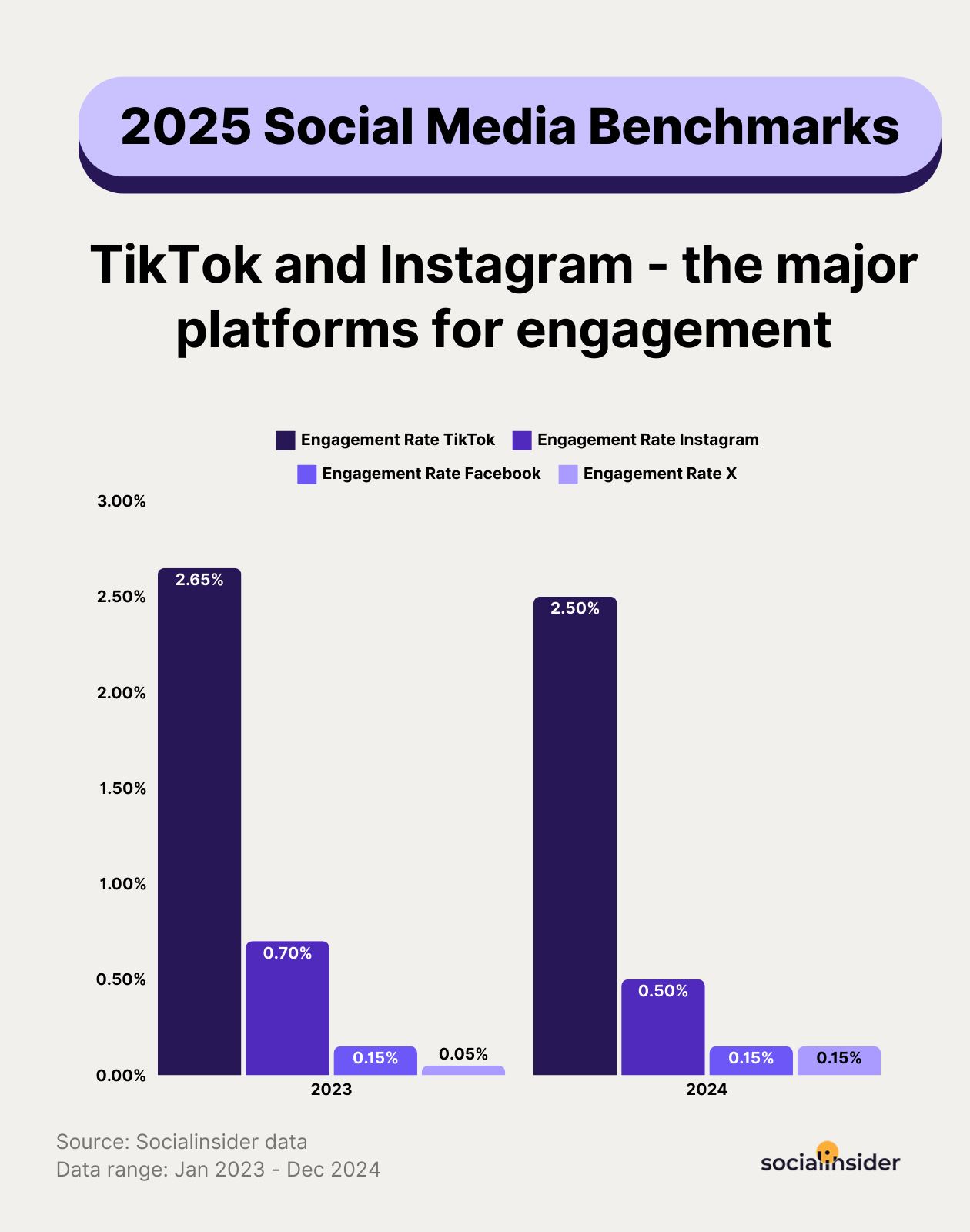
Content data
The data evaluates content effectiveness and helps you uncover patterns to build more laser-focused social media content strategies.
- Historical post data: With access to historical content performance data, you can analyze social media trends over time, spot seasonal patterns, and evaluate the long-term impact of your content strategy.
Socialinsider is an AI-powered social media analytics tool that lets you access and analyze historical post data across multiple social channels. By connecting your social media page to Socialinsider, you can get access to up to two years of historical data to understand how specific campaigns contributed to growth and assess the effectiveness of different content types over time.
- Top-performing posts: These are the posts that have received the highest engagement or reach within a specific time frame. Identifying top-performing posts can help you understand what type of messaging, tone, or visuals drive the best results.
To see your top-performing posts as well as your competitors, connect the relevant social media page to your Socialinsider dashboard and navigate to the ‘Posts’ section. You can also select a specific time period to analyze performance trends over days, weeks, or months.
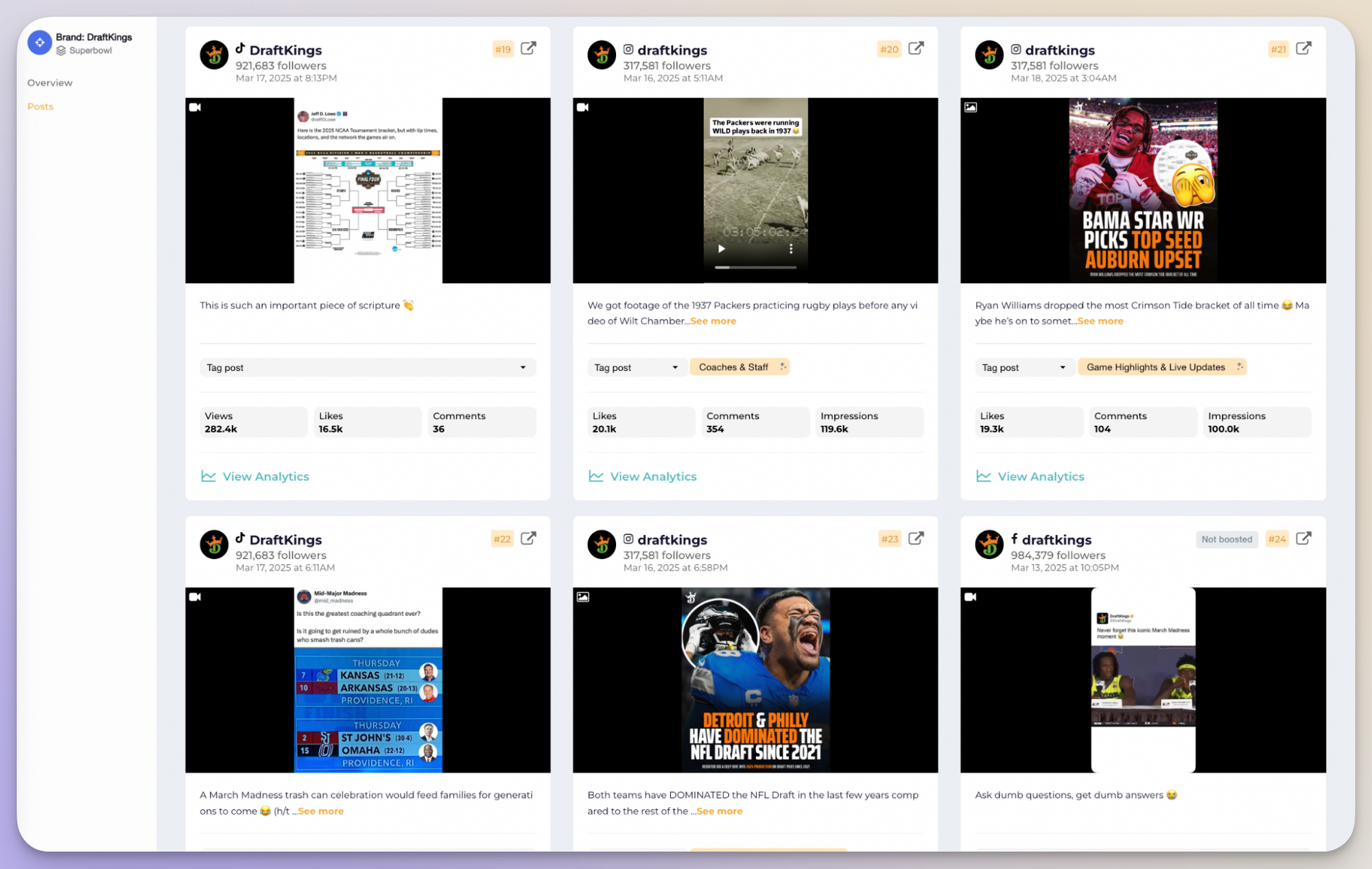
- Best-performing content formats: This data shows which formats, such as videos, carousels, images, or Stories, perform best on each platform. It helps you prioritize formats that align with your marketing goals, whether that’s driving engagement, reach, or conversions.
To identify your best-performing content formats, head to the ‘Engagement’ section in your Socialinsider dashboard and scroll down to the 'Post types.'

- Most engaging content pillars: Content pillars represent your brand’s core topics or themes. Knowing which pillars consistently drive engagement allows you to refine your content mix and double down on what your audience cares about
To find your or your competitors' most engaging content pillars, open the profile page in your Socialinsider dashboard and go to ‘Content pillars.’
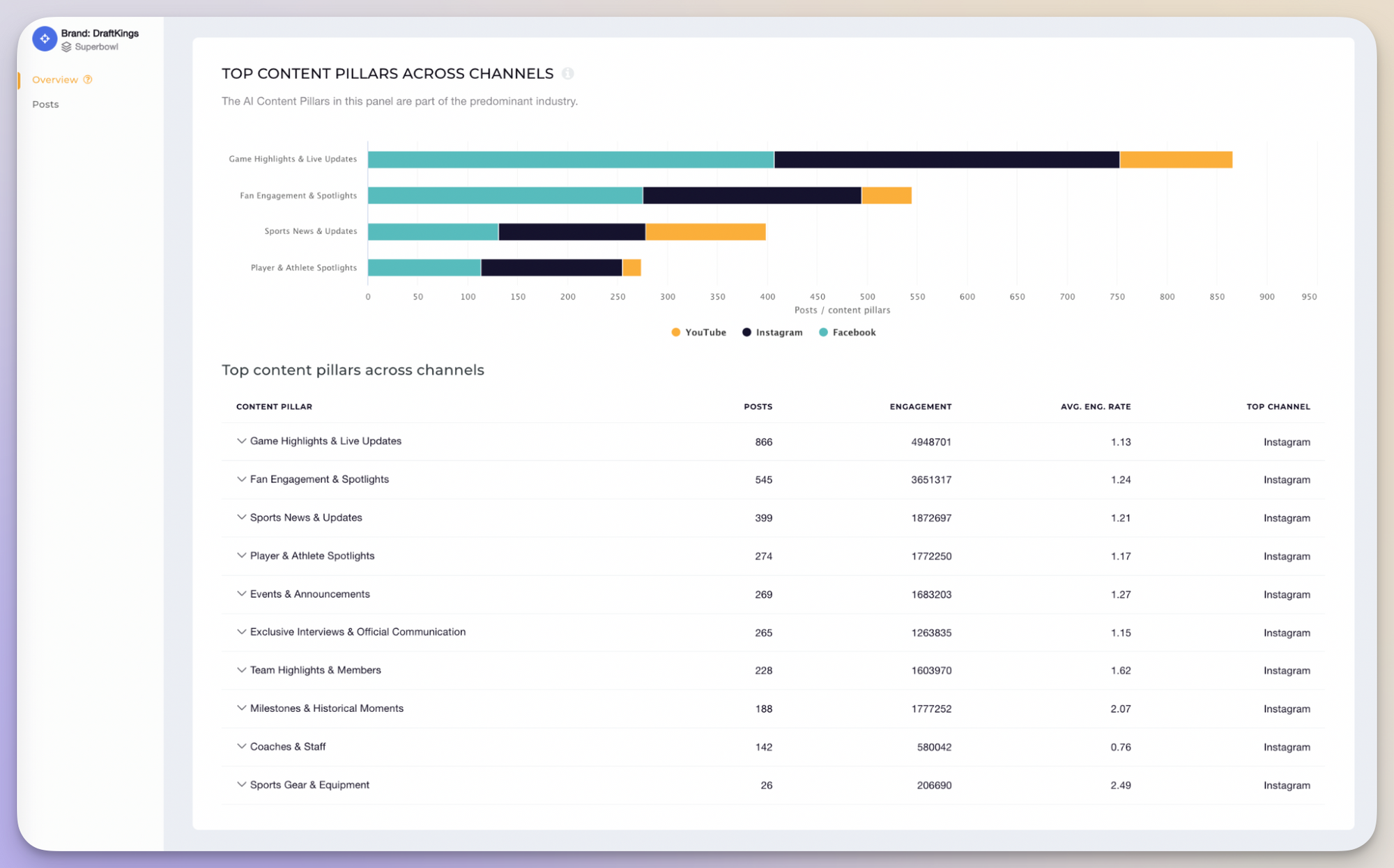
Competitive data
Competitive data gives you an inside look into what the other brands are up to. You can benchmark against industry peers, spot gaps, and stay one step ahead of your rivals.
- Followers: Tracking how your follower count changes on each platform over time and comparing it to your competitors can help you understand how well your brand is attracting and keeping attention.
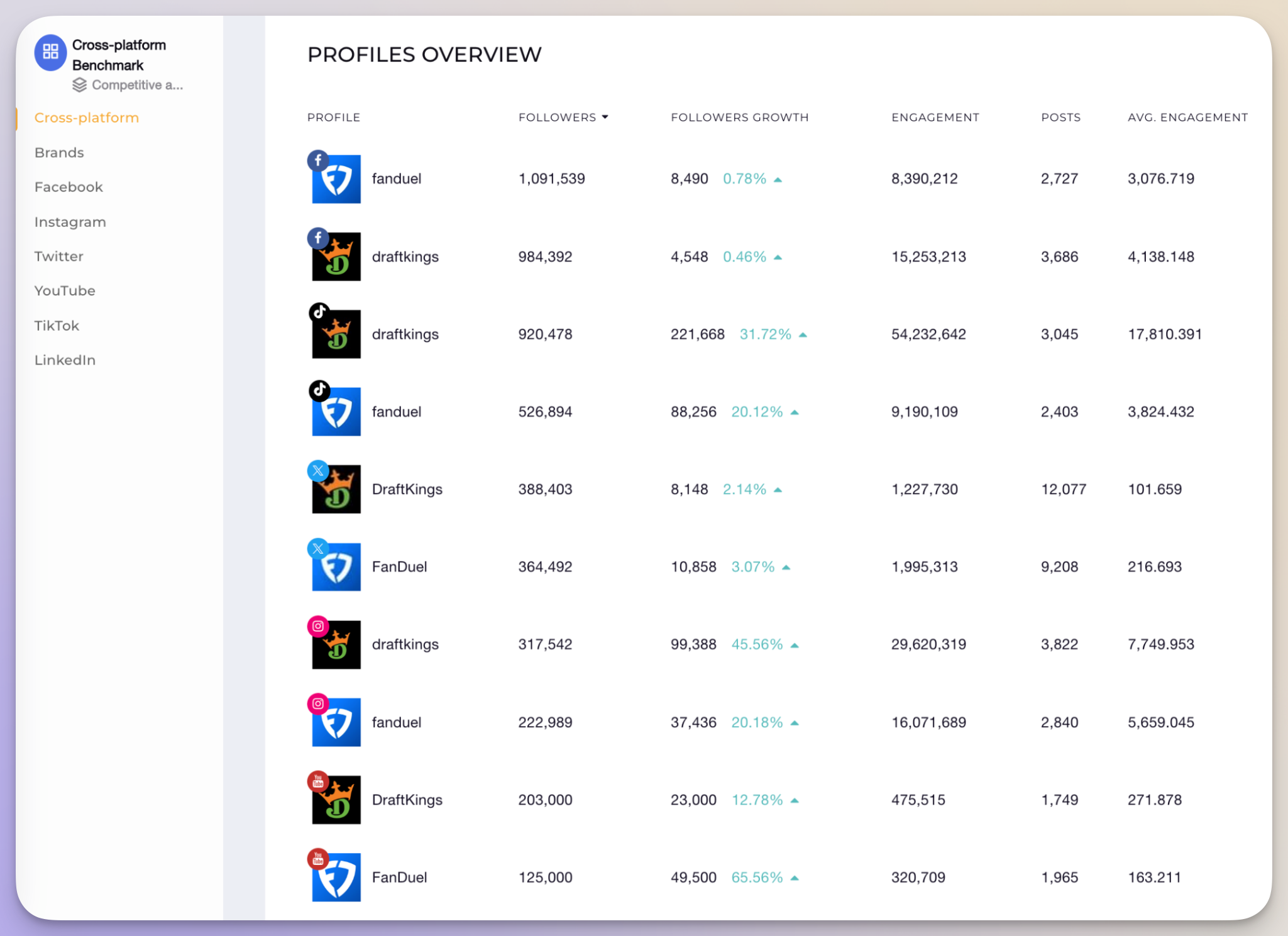
- Reach: Determine whether your content is getting in front of as many people as your competitors, and if not, then why.
- Engagement and engagement rate: See how your audience's interaction compares to others in your industry.
- Content pillars: Analyze competitors’ major content pillars to see which themes resonate most with their audiences. Then, identify gaps in their strategy–topics they’re not covering or not performing well on. Consider including those in your content mix.

Industry benchmarks
Industry benchmarks help identify what a good social media performance looks like in your space so you can set realistic goals for your campaign.
All the standard brand awareness, engagement, and content performance data can be benchmarked to assess how your brand measures up against the industry standards.
You can use this data to validate strategies, analyze KPIs, and measure performance outcomes.
Sentiment analysis
Sentiment analysis helps answer whether the audience is responding positively to your brand and social media campaigns or not.
- Sentiment score: It measures the overall tone (positive, neutral, or negative) of mentions or messages. The score usually ranges from -1 (very negative) to +1 (very positive). It can monitor shifts in perception and help you refine content strategy accordingly.
- Sentiment ratio: It's the ratio of positive to negative mentions, which is also useful for benchmarking sentiment shifts over time.
- Sentiment by channel: It provides a breakdown of sentiment across different social media platforms to identify where tone differs. Marketers can then use the data to adapt different messaging and engagement tactics for each platform.
- Influencer sentiment: It filters brand mentions from high-impact users or influencers to understand their tone toward the brand. The data can help analyze how influential voices in your niche are framing the brand sentiment so that you can build more informed influencer collaboration strategies.
Top social media data collection methods
So, now that we have discussed all the different types of data you can use, let’s take a look at how to collect data from social media.
Extensive off-platform tracking
Platforms like Facebook (Meta), X, and LinkedIn offer tracking pixels that brands can install on their websites, ads, or landing pages to collect customer data. These tiny 1x1 pixels collect details about users, such as their location, device type, operating system, and other browsing data.
Pixels enable cross-platform attribution, connecting social content to downstream website behavior and conversions.
Data collected from pixels can be used to refine marketing strategies, deliver personalized content, optimize retargeting campaigns, and improve sales conversions.
The type of data you can collect will depend on the social media pixel you’re using. For instance, Facebook Pixel can track various user actions on websites and apps, including:
- Page views
- Click on CTAs
- Leads captured
- Purchases
- Add to cart
- Other custom events like downloads, video plays, and submissions
While tracking pixels can be a great way to collect user data, keep in mind that there are now continuously tightening regulations around data privacy. It's important to make sure user consent is properly managed when using pixels.
Surveys and polls
You can use surveys and polls to collect structured feedback directly from your audience right within the social media apps. They give marketers real-time insights into how people feel about their brand, campaigns, or even specific content topics.
The biggest benefit of using surveys and polls is that they are non-invasive, easy to collect, and great for validating assumptions about your audience. These are supported on only a few social media platforms and formats, including:
- LinkedIn: Native polls in posts or groups
- Instagram Stories: Poll stickers and question boxes
- Twitter/X: Polls in tweets
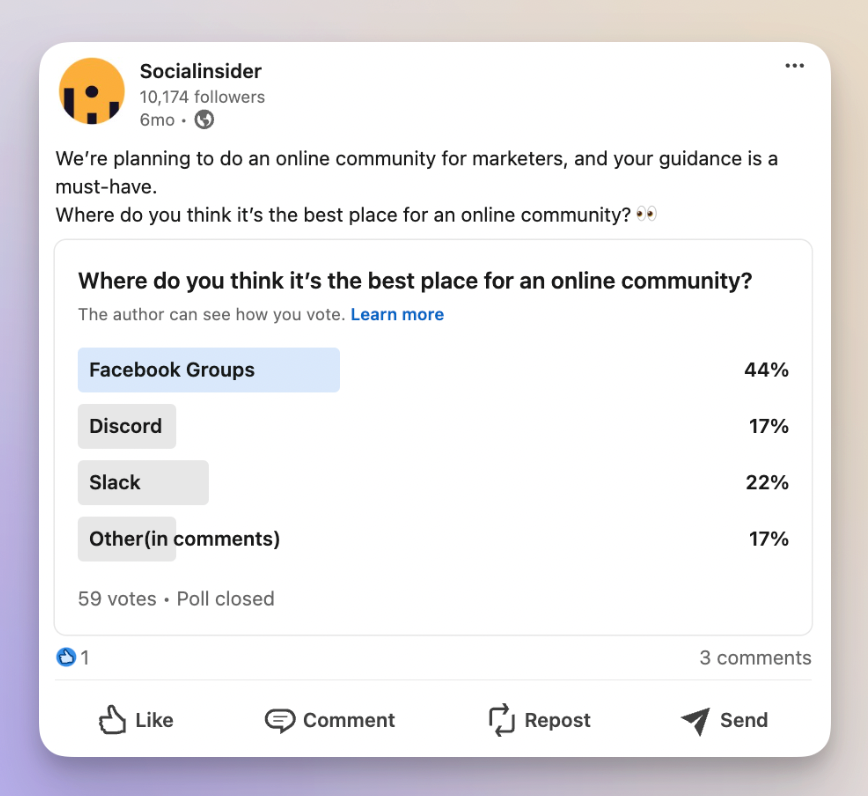
Direct engagement
Direct engagement is one of the most authentic and qualitative ways to collect social media data. This includes:
- Asking open-ended questions in captions and responding to comments;
- Running AMA-style (Ask Me Anything) sessions;
- Monitoring comments for recurring themes, praise, or objections;
- Following up with users who engage frequently to probe deeper.
When scaled across multiple posts and campaigns, this method builds community and helps you understand what your most engaged audience cares about, wants, or critiques.

Social media analytics tools: for trend identification
Social media analytics tools can collect and organize large amounts of raw social media data, including user interactions, audience demographics, and content performance.
You can use these social media marketing tools to spot rising trends, topics, formats, or themes before they peak and align your content with what’s gaining traction in real time.
For integrated multi-platform analysis, you can use Socialinsider, which is a simple and straightforward social media analytics tool built especially for busy marketers. Compare your brand's performance across channels, get competitor analysis, and identify the top content pillars that drive the most engagement–all through one dedicated dashboard.
You can track all of your brand’s social media profiles together to compare how trends emerge across different platforms. For marketers, this means staying ahead of trends—not reacting to them.
Social media listening tools
Listening tools scan social media platforms for brand mentions, hashtags, and comments. These insights can be used to refine messaging strategy, customer care, product development, and even competitive positioning.
The tools can help with:
- Sentiment analysis: Understanding whether mentions are positive, neutral, or negative.
- Topic clustering: Identifying recurring themes, concerns, or product feedback.
- PR crisis detection: Catching negative spikes in mentions early before they escalate.
What social media data collection tools to use?
There are many data collection tools available out there, but the right one for your brand will depend on your exact requirements. You can also use a combination of these tools for more accurate analysis.
Native analytics: for audience analysis and basic performance reporting
Native or in-built analytics tools provided by platforms like Facebook, LinkedIn, and X (formerly Twitter) offer core social media data on engagement and content performance.
However, these tools tend to be basic, with limited historical data and platform-specific insights.
The main common native analytics tools include:
- Facebook and Instagram (Meta Business Suite): Offers data on reach, impressions, engagement, audience demographics, and post-level insights.
- LinkedIn analytics: Includes follower growth, job function, and industry of followers, post performance, and engagement rates.
- X (formerly Twitter) analytics: Delivers metrics on tweet engagement, reach, profile visits, and audience interests.
- Tiktok analytics: Provides a deep dive into your video performance and audience
Socialinsider: for in-depth metrics, cross-channel analysis, and competitive insights
Socialinsider’s social media API collects data from various platforms, including Meta (Facebook/Instagram), Twitter, TikTok, LinkedIn, and YouTube. This aggregated, customized data transforms into insights that you can use to create more valuable products and better meet your clients’ needs.
The tool has features such as
- Historical data collection: Access to historical data going back up to 12 months, with the possibility of extending to 24 months.
- Data update frequency: View updated data that’s refreshed every 8 hours for Instagram and Facebook and every 12 hours for Twitter.
- Metric monitoring: Track key metrics such as engagement, impressions, reach, video views, and follower growth.
- Competitor analysis: Gain insights into your competitors’ social media performance by analyzing their metrics side by side.
- Content categorization: Organize your posts automatically using AI content pillars or apply manual tags for customized grouping.
- Post‑level analytics: Dive into granular post data, such as likes, comments, shares, and views, to understand exactly what resonates with your audience.
The data collected can be exported in various formats, including PDF, PowerPoint, or spreadsheet, and can be used for competitive analysis and content performance evaluation.
Looker Studio: for large dataset integrations
Looker Studio is a data visualization and reporting tool that helps marketers aggregate large datasets from multiple sources, including social platforms, CRM's, ad platforms, and web analytics tools.
Tools like Looker Studio simplify data gathering by integrating insights from multiple platforms into one dashboard.
Its main features include:
- Data integration: Combine data from other analytics like Socialinsider, Google Analytics, Meta Ads, and LinkedIn Ads.
- Custom dashboards: Build branded, real-time dashboards tailored to different stakeholders.
- Automated updates: Schedule refreshes and eliminate manual reporting workflows.
How to effectively leverage social media data collection?
The best way to collect social media data is to align your tools and methods with specific goals, like brand awareness or competitor benchmarking.
Let’s take a look at the steps to collect and use social media data.
Define the goals of your social media data collection
Before you even start collecting social media data, you need to clarify the reason behind your strategy.
- Do you want to assess your brand’s perception in the market?
- Do you want to optimize your content strategy for specific social media KPIs?
- Do you want to track and benchmark competitor performance?
- Do you want to identify emerging trends?
Choose the platforms that are relevant for your analysis
You don’t need to collect just about every data available under the sun. Choose platforms based on where your audience is the most active and what your business goals are.
Keep in mind that each social media platform offers different types of data and audience insights. Focusing your efforts in the right places ensures you're not diluting your strategy with irrelevant metrics.
Select the collection methods and tools
There are two main types of social media collection methods: quantitative (metrics and performance) and qualitative (sentiment and context). Your goals will determine which one of the two you should be using.
- For quantitative tracking, tools like Socialinsider can help you gather performance data and offer insights.
- For qualitative analysis, consider using social listening tools or native surveys/ polls to collect customer sentiment.
Collect, double-check for accuracy, and analyze your data
Your collected social media data will be unusable if it's not accurate, which is why it's important to take steps to maintain data hygiene.
Here are some steps you can take to validate your data for accuracy before you analyze it
- Check for gaps or duplicates in historical post data;
- Standardize the content pillar names for easy categorization;
- Filter out any anomalies like boosted or sponsored posts that might be skewing averages for organic posts.
Draw insights that you’ll integrate into your further strategies
Once your data is collected and cleaned, look for patterns, trends, and outliers.
To connect the dots between your data and insights, focus on questions such as:
- What content formats are driving the most engagement?
- What platforms are delivering the most conversions or traffic?
- What is the most engaged audience segment?
- When is your target audience the most active?
- How does your brand’s performance compare to the competitors or industry benchmarks?
Make sure to build a feedback loop where data continuously influences the marketing strategy, and the strategy decides what data you prioritize next.
Social media data collection challenges
Collecting social media data at scale comes with a number of practical and regulatory challenges. Below are some of the most common challenges we’ve heard directly from our customers.
Platform limitations and API restrictions
Each platform has its own rules, access levels, and constraints that impact the depth and breadth of available data.
- YouTube: Unlimited access to posts and video-level data.
- Facebook and Instagram: Up to 2 years of posts data.
- LinkedIn: 1 year of posts data available.
- X (formerly Twitter): Data access depends on volume. Low-volume accounts can provide up to 2 years of posts.
- Public pages: These offer post and engagement data but no follower evolution or follower count history.
- Instagram: No competitor data is available for Stories, watch time, and Reel replays. Instagram Mentions are accessible only for connected accounts, and there’s limited monitoring scope.
Access to private vs public data
Regulations and platform policies can restrict access to personal or non-business profiles, limiting visibility into full audience behavior.
- Business profile data: Accessible with proper authorization.
- Personal profile data: Restricted due to API policies and privacy laws.
- Reach and impressions: Often modeled or estimated.
Historical data constraints
Historical data is often limited by platforms, which can make long-term analysis challenging.
Data quality issues
API inconsistencies and limitations can affect the reliability of certain metrics.
- Key metrics like reach, profile visits, and views (especially on Instagram) are sometimes only available via native apps and for only your account.
- Frequent platform updates or redefinitions of metrics can lead to inconsistencies over time.
Legal and regulatory concerns
Platforms are under pressure to offer more privacy control options, limiting access to granular behavioral data. For brands, that translates to:
- Staying compliant with each platform’s terms of service.
- Staying informed about the GDPR, CCPA, and similar laws to understand what kind of user data can be collected and stored.
Future trends in social media data collection
To future-proof your social media data collection and marketing strategies, you need to keep up with emerging trends and innovations.
Emerging technologies
Take a look at the top technologies that are making it easier and faster to collect comprehensive social media data.
- Cross-channel analysis: Combining datasets from different social media platforms to better understand audience behavior.
- Automated tagging systems: Automating the classification of content types, campaign themes, and sentiment categories.
- Automated behavioral prediction: Forecasting audience engagement trends.
AI and machine learning in data processing
Using AI and machine learning in social media, marketers are able to analyze larger and more complex datasets at a faster pace.
Social media AI tools can help you with
- Predictive analytics: Using historical data to forecast content performance and audience engagement.
- Natural Language Processing (NLP): Assessing user comments and brand mentions for sentiment analysis and topic clustering.
- Content recognition models: Automatically tagging visual and video assets by content topic or sentiment.
- Anomaly detection: Identifying unexpected performance spikes or drops without manual tracking
Privacy-focused changes
Privacy regulations and platform changes are redefining what’s accessible and what’s ethical in data collection. This is set to change the way brands collect data.
- Cookieless tracking models: A cookieless future means brands will rely less on third-party tracking and more on first-party data as well as platform-native insights. This will challenge brands to build direct relationships with audiences and implement consent-based data collection.
- Constantly evolving platform policies: Evolving social media platform policies increasingly limit the type and depth of user data available to brands. With tighter restrictions on tracking and API access, brands will have to focus more on aggregated insights and ethical data practices.
Final thoughts
Knowing how to collect and utilize social media data is key to unlocking ROI. Prioritize data that aligns with your business goals, benchmark against rivals, and adapt to emerging trends.
For seamless analysis, use Socialinsider to turn raw data from different platforms into actionable strategies. Ready to lead?
FAQs on social media data collection
What are the differences between data collection vs mining vs extraction?
Data collection is all about gathering raw information from various sources. Data extraction involves pulling specific data from a larger dataset or platform. Data mining, on the other hand, is the process of analyzing collected data from social media to uncover patterns, trends, or insights.
How do social media analytics tools collect data?
Most analytics tools collect data through official APIs provided by platforms like Meta, LinkedIn, TikTok, and YouTube. These APIs deliver structured access to metrics and user interactions in compliance with each platform's terms of service.
How does TikTok's data collection compare to other social media platforms?
TikTok collects audience behavioral data, including watch time, scroll patterns, and interaction types, to build a highly personalized feed for its users. Compared to platforms like LinkedIn or YouTube, TikTok emphasizes real-time engagement signals over already known user interests.
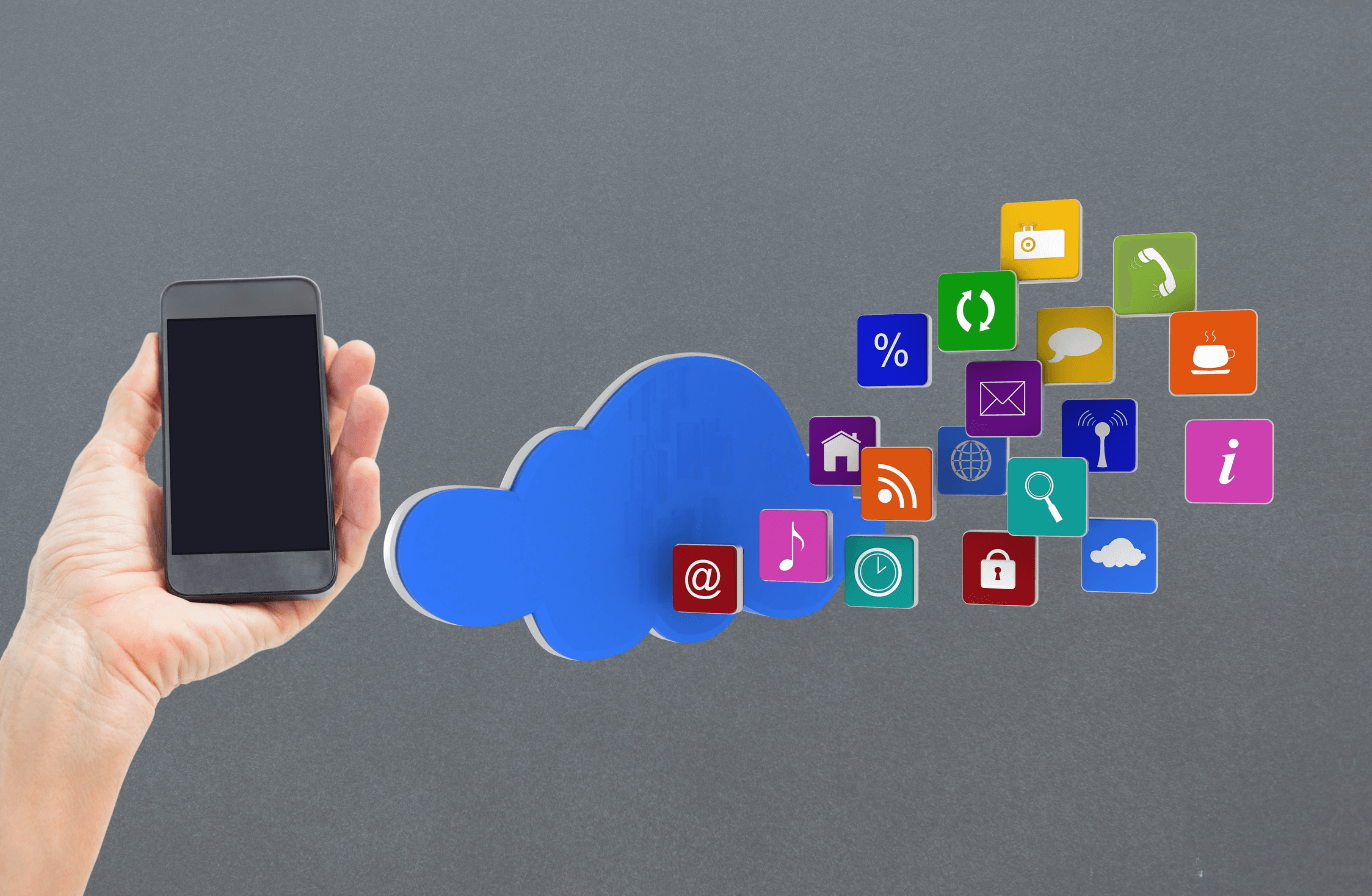







![[What Data Says] How Many Social Media Interactions Does Every Platform Drive](/blog/content/images/size/w1000/2025/03/interactions.png)